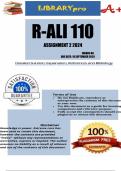R-ALI 110
ASSIGNMENT 2 2024
UNIQUE NO.
DUE DATE: 19 SEPTEMBER 2024
, lOMoARcPSD|21997160
DIPLOMA IN GRADE R TEACHING
ASSIGNMENT 2: 19 SEPTEMBER 2024
THIS ASSESSMENT COVERS UNITS 1 - 3
MODULE NAME ACADEMIC LITERACY
MODULE CODE R-ALI 110
NQF LEVEL 5
EXAMINER MR J.C. RADEMEYER
INTERNAL MODERATOR MS L. ENGELBRECHT
ACADEMIC HEAD DR G. HARRISON
TOTAL MARKS 100
PURPOSE: The purpose of this PDF is to do preliminary work on your assessment in
preparation for online submission.
INSTRUCTIONS:
a) Read each question carefully and look at the mark allocation to guide your response.
b) Answer all questions in English, except for the language modules. The language to use when
answering the questions for the language modules will be stated in the front matter, e.g.,
answer in Afrikaans/isiXhosa/isiZulu/Sepedi/Setswana.
ASSESSMENT PAPER
c) Attempt to complete all questions. Do not leave questions unanswered.
d) All submitted answers must be written in your own words. Evidence of plagiarism and
improper paraphrasing will be further investigated.
e) Using artificial intelligence (such as ChatGPT) to produce content and images and
then represent these as your own work is considered a severe irregularity that will be
penalised accordingly.
f) Include in-text references where applicable (including referring to the CLG), as you will
have to declare your sources at the end of the paper. The list must be made in accordance
with the Harvard-style Referencing Guide employed by SANTS.
g) Refer to the Student Orientation Booklet on MySANTS for information on referencing and
plagiarism.
a) Use a separate document to draft your rough answers.
b) Hereafter, copy your answers to the platform using Google Chrome or Firefox as your
SUBMISSION
web browser.
c) Carefully check each response before submitting any assessment, saving as you complete
each question.
d) Please note that online submissions should be conducted through your laptop computer,
desktop computer, or tablet. If possible, avoid using your cell phone.
e) Please take note that only one submission per student will be allowed.
a) Should you experience any challenges, notify SANTS immediately.
SUPPORT
b) You can also consult your MySANTS Student Manual and the SMS you were sent linking to
the Guide on how to complete an Assignment:https://lms.sants.co.za/Files/Students.pdf.
c) Login to MySANTS, select Enquiry and then insert your query to receive support.
d) Support is ONLY available from 8:00 to 16:00 on weekdays.
Page 1 of 17
, lOMoARcPSD|21997160
QUESTION ONE 10
Question One consists of five (5) questions.
• Read Unit 3, Academic Writing, Section 1, in your R-ALI 110 Curriculum and Learning
Guide (CLG).
• Then, read Case Study 1, An Example of Taylor’s Essay, before answering questions 1.1
– 1.5.
• Select NEXT to begin this section.
Access and study the support material (uploaded to Additional Resources on MySANTS LMS
or right-click on the link and select OPEN LINK IN NEW TAB).
Unit 3, Academic Writing, Section 1B https://lms.sants.co.za/Files/Resource/438463b5-
(Planning and Writing Academic Essays: d930-4d71-ba04-245c77deb47c.pdf
Fundamentals of Writing Good Essays)
Unit 3, Academic Writing, Section 1C https://lms.sants.co.za/Files/Resource/1b6e96d8-
(Planning and Writing Academic Essays: d52b-4aaa-9ca7-82d173e57c95.pdf
Introductory Paragraph)
Unit 3, Academic Writing, Section 1D https://lms.sants.co.za/Files/Resource/211343de-
(Planning and Writing Academic Essays: ef01-4663-b510-b22628ab3475.pdf
Conclusion)
Case Study 1: An Example of Taylor’s Essay
In her first year at SANTS Private Higher Education Institution, Taylor received an important
Academic Literacy assignment. She is tasked with writing an academic essay on the critical
topic of plagiarism and copying within Higher Education Institutions, emphasising that these
acts must be regarded as severe transgressions. Taylor eagerly dives into her research,
exploring the ethical principles that underpin academic integrity. As she investigates her
studies, she learns about the consequences of academic dishonesty and its impact on student
success and future academic careers. Taylor's essay below (the introductory and concluding
paragraph) serves as a powerful reminder to her peers and educators of the importance of
upholding ethical standards in their academic journey.
Introductory paragraph:
As future educators and role models for the children of South Africa, education students bear
a responsibility to uphold ethical and professional standards, ensuring the submission of
original work free from irregularities (Ferreira-Prévost, 2022, p. 1). Academic integrity covers
a commitment to six core values: honesty, trust, fairness, respect, responsibility, and courage
(ICAI, 2021). Therefore, plagiarism and copying within Higher Education Institutions must be
regarded as severe transgressions. Firstly, this essay will explore the significance of academic
integrity within Higher Education institutions, starting with a definition of academic integrity
itself, secondly with a discussion of academic dishonesty, and lastly with an evaluation of the
effects of plagiarism on student success and future academic careers.
Page 2 of 17
, lOMoARcPSD|21997160
Concluding paragraph
This essay has demonstrated that as prospective educators in South Africa, teachers must
uphold the principles of academic integrity and ensure that the work we submit is both honest
and original. The commitment to values such as honesty, trust, fairness, respect,
responsibility, and courage is the cornerstone of maintaining the ethical standards that South
Africa's educational system relies upon. Therefore, education students must view plagiarism
and copying as serious transgressions within Higher Education Institutions. By understanding
the essence of academic integrity, recognising the downsides of academic dishonesty, and
acknowledging the disadvantageous impact of plagiarism on student success and future
academic careers, education students can pave the way for a more ethical and responsible
educational environment for the benefit of students and society as a whole.
Figure 1: Key structural elements of introductions and conclusions (The University of
Melbourne, n.d.)
(Rademeyer, 2023)
Please answer the following questions by SELECTING the correct answer.
1.1. The introductory paragraph of Taylor's essay provides background information on the
topic of plagiarism and copying within Higher Education Institutions. [2]
A. True.
B. False.
1.2. In the introductory paragraph, Taylor includes a clear thesis statement which indicates
what she will discuss in the essay. [2]
Page 3 of 17




